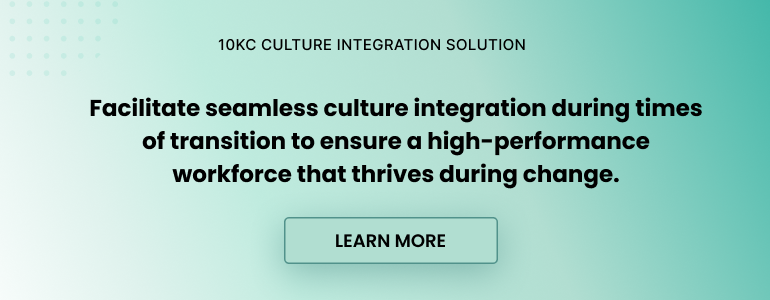There’s a lot of chatter about company culture. And for good reason. Companies that prioritize culture and organizational health see an average of a 3x increase in shareholder returns. But for all the talk about company culture, it’s often the one area where companies fall short—especially when in times of change like mergers and acquisitions (M&A).
Nurturing workplace culture during periods of transition is critical to company success. And the overwhelming majority of senior leaders would also agree. 95% of executives would say that culture fit is critical to the success of integration.
With the right approach to culture integration, your company can maximize value, boost employee engagement, and increase resiliency through different seasons of organizational change.
Keep reading as we break down the benefits of culture integration, when it should be a priority, and the strategies you can leverage to effectively achieve company cultural alignment.
What is culture integration?
Culture integration in the workplace is when multiple company cultures come together to create an entirely new culture.
It’s a vital process in times of transition, such as mergers, changes in leadership, or even expansion. The goal of culture integration is to improve the work environment for employees so they can effectively support company goals.
Culture integration isn’t the replacement of a culture. Rather, it’s taking the best parts of existing cultures and merging them together to create a unified organizational culture that allows a company to take advantage of the best of both worlds.
Culture integration examples and scenarios
Culture integration usually occurs following a major change within the business. Here are a few times when you might find yourself integrating cultures within your organization.
Mergers & acquisitions (M&As)
When we think about culture integration, M&A is often one of the first scenarios that comes to mind. Whether your company is merging with or acquiring another business, it’s impossible to keep the status quo. There needs to be a culture established for the new entity.
For example, a large corporate organization may acquire a smaller start-up. It’s safe to say that those two company cultures would look different at the point of acquisition, which means integration is critical to carving out a new path forward.

Rapid company expansion
Companies that go through periods of extreme growth are often faced with an influx of new employees, leadership, and even customers. This often means that the company culture needs to quickly adapt to the new needs of the business.
Consider a start-up that experiences massive growth. This means they may go from 20 employees to 200 in a short period of time. This requires new policies and processes to accommodate that growth—which changes how the company operates on the day-to-day, including management practices or even employee mindsets.
READ MORE- Change Leadership: A Guide for Organizational Growth
Changes in leadership
Senior leadership plays an important role in establishing and fostering company culture. So when new senior executives join an organization—from CEOs to department heads—they often bring with them a new way of working.
The new way may not necessarily be better or worse, it’s just different. However, it does require employees and the organization to adapt, which ultimately impacts the overall company culture.
Updates to team configurations, restructures, and layoffs
You can also have culture changes within an organization itself. When employees are moved around internally, it can create a shift in dynamics and relationships.
For example, when teams are reconfigured due to restructuring they might work with existing employees, but they’re new to them—which influences micro-cultures within the organization.
And when major changes, such as layoffs occur, they can also negatively impact employee morale and engagement, forcing companies to readjust to accommodate those changes.
Responding to market change
Businesses are constantly changing. But when the market forces companies to do business differently, the changes can be more abrupt and more drastic.
With changes to company priorities and objectives come changes to company culture. This means existing employees need to adapt to the new values and new way of work.

The importance of M&A culture integration
While M&A isn’t the only reason for culture integration, it’s certainly one of the most common. In the M&A process, organizations spend time and resources determining how to best integrate business strategy to maximize value in the transaction.
However, culture is often left on the back burner and often ends up posing one of the biggest challenges.
A PwC study found that as high as 65% of acquirers cited cultural issues as a major obstacle in creating value in their deals. And when you think about it, it makes perfect sense.
We know that employees are one of the most important assets for any organization. So when their ability to do impactful work is jeopardized, it can quickly affect everything from productivity to revenue.
Even where acquiring organizations have assessed a culture fit with the acquisition, there’s still a learning curve for everyone involved. Cultures don’t magically merge overnight.
With M&A in particular, employees are often expected to suddenly work with a new team that has a completely different set of values and approaches to work. This divide can create misunderstandings that influence the ability of employees to work cohesively. It can create redundancies or miscommunications that impact the value of their work—or hinder it altogether.
It’s an experience that is frustrating not only for organizations but employees themselves. Over time, they’ll become burnt out, disengage, or leave the company entirely—all of which impacts the value of the M&A.
It’s clear that strategy transitioning company culture in M&A is equally important to that of other core business objectives. So much so, that a McKinsey study has found that companies that manage culture effectively in M&A integration planning are approximately 50% more likely to capture cost and revenue synergies.
“The lack of culture integration will create a fragmented team. And it's that cohesion that creates silos and reduces velocity in organizations. The very goal that you're after for bringing people together to create the synergy of an acquisition ends up being what's pulling people apart. So I would definitely, in the next [acquisition], double down on getting that part right first.” - Alim A. Dhanji , Chief People Officer & EVP, Equinox Group
So, where do you even start with culture integration? Well, workplace culture is all about the beliefs and relationships within the company. So like most relationships, aligning on company culture starts with fostering connection.
Why building employee connections is key to successful culture integration
You can’t have a unified company culture if employees don’t have solid relationships with their peers and the organization as a whole. It’s not uncommon for these relationships to falter in times of uncertainty—which tend to go hand in hand with change. However, the risk of these chasms can be significantly reduced when employees feel connected with one another.
Here are a few reasons why connectivity should be a part of every culture integration plan.
1. It increases transparency
When employees feel connected to their peers, it increases the flow of communication within an organization. While promoting organizational transparency should always start at the top, employee connections make it easier to share information across the company.
Employees who feel a sense of connectivity are more likely to trust each other and the organization. This means when critical information is shared regarding business changes, employees are more open to hearing it. They’ll also be more comfortable clarifying information where needed to avoid gaps in communication—both in their everyday tasks and with business decisions.
2. It fosters cross-team collaboration
You can put two people in a room together, but if they won’t work together it’s unlikely they’ll be able to get on the same page. The same goes for integration. If people on both sides of the table don’t work with one another, it’s difficult to find common ground.
Building meaningful connections between employees encourages collaboration. When teams are comfortable with each other, they’re more likely to find ways to work together
3. It allows employees to build psychological safety
Change is scary. Organizational transformation—while a natural part of any business—can leave employees concerned about the implications on their own roles. This can make for a stressful work experience that puts employees at risk of burnout and can create unnecessary friction between teams.
When employees feel connected, it allows them to embrace their vulnerability. They can ask questions about the changes that are happening and get clarity in the direction of the business and their immediate teams.
“The culture of an organization, and how open or transparent or psychologically safe that culture is at large, absolutely influences the way people experience change. So, as a leader, I think one of the most helpful things you can do is be upfront about those things.” - Catherine Brown, Founder, Taybridge Leadership
4. It promotes inclusivity
A cohesive company culture increases inclusion. However, when it’s fragmented, employees can get left behind.
Consider an acquisition. Employees of the acquired company can easily feel second fiddle to the employees of the acquiring organization, especially if they’re never connected with or have even been introduced to their new peers.
Of course, successful culture integration still hinges on strong change management and leadership. However, you can get the ball rolling faster (and more effectively) by intentionally building employee connections. As employees on both sides of the table interact and become more comfortable with one another, the company cultures will naturally start to merge.
5. It increases employee engagement and boosts employee retention
Keeping employees connected in these times creates a sense of belonging and loyalty that promotes employee retention.
Organizational transformation can be volatile. It can easily create disengaged employees who ultimately leave the organization.
The irony is that this is often when companies need to retain top talent the most. Employee resources are often a key factor in an acquisition, and high-potential employees often serve as a pipeline for future growth. These leaders are also the influential employees needed to champion culture integration.

Talent development programs to drive culture integration
Culture and connection come down to one thing: your people.
So, investing in and developing talent should be a part of any culture integration strategy. It helps move your culture goals forward while demonstrating a commitment to continued employee growth.
We’ve rounded up some talent development programs and initiatives that can help you successfully navigate change and improve culture integration.
Mentorship
Mentorship isn’t a stranger to employee development. We know it’s a valuable tool in giving employees the resources and development opportunities they need to grow in their professional lives.
But mentorship also serves another purpose. It builds employee networks within your organization.
In fact, when it comes to culture, mentorship doesn’t even have to be the traditional senior-junior relationship that we often think of. Peer-to-peer mentoring can be incredibly successful in breaking down the silos that can come with fragmented employee culture.
Meeting new people in a work setting, particularly during major changes, can be awkward. Pairing employees from different teams and backgrounds for 1:1 introductions can help them meet new people and build relationships outside of the transactional ones.
Think about a company merger. It’s easy and more comfortable for employees to stick to the status quo and interact solely with people they’ve already worked with. Mentoring can facilitate those intros while reducing the barriers to building new connections. It also eliminates the ‘us vs. them ’ mindset that can often be prevalent in M&A.
The idea is that those intros turn into cross-team collaboration, innovation, and of course, business performance.
Culture onboarding
The term onboarding is typically tied to tangible things like software and processes. We don’t often think of onboarding employees to things like company culture.
However, just like an employee needs to learn the ins and outs of a new role, culture onboarding can help employees better understand changes in company culture.
When employees are left to figure out company culture on their own, they can either miss the mark or just end up frustrated with a lack of understanding around cultural company decisions. Onboarding and clear communication around changes in company culture can eliminate these misunderstandings.
Now, it doesn’t have to look like your typical employee onboarding program. Even simple initiatives, such as small group roundtables hosted by internal change champions can help clarify the implications of culture integration. It provides a platform for employees to ask questions and better understand what culture looks like within your organization going forward.
Strategic alignment
To effectively integrate culture, you need to get everyone on the same page. This means you should be creating ways for that information to be communicated to your employees.
Company-wide resources and leader-led group sessions are valuable tools for welcoming new teams and sharing strategic priorities so they know what to expect.
On the other hand, it’s also important to ensure that your company values meet the expectations of those of your employees. By demonstrating your commitment and support to employee career development and growth, they’re more likely to feel that their priorities are aligned with your company—encouraging employee engagement and retention.
Change management
Employees look to leaders for guidance in times of uncertainty. And while leaders can’t—and shouldn’t—be expected to have all the answers, they should have the skills to motivate and bring together teams from different company cultures.
Your culture integration strategy should also nurture effective change leaders. For example, you may consider providing people managers and leaders with training and learning opportunities to develop their change leadership toolkit. Mentoring programs that pair leaders from different functions and backgrounds can also help them build their skills and collaborate on strategies to successfully navigate change.

How 10KC facilitates more effective culture integration
Company change doesn’t always have to be chaos—in fact, it shouldn’t be. Let 10KC be your partner in creating a workforce that thrives in times of change.
Whether you’re navigating cultural challenges post-M&A or simply want to unify your existing team, 10KC’s Culture Integration Solution can help.
With 10KC organizations can:
- Create cultural alignment among employees: Networking programs and targeted group sessions, such as Leadership Roundtables and AMA sessions, help ensure that everyone is on the same page.
- Foster connection and cohesion: Employee introductions at scale can break down silos and connect employees across teams and facilitate collaboration.
- Retain talent in times of change: Mentorship and development programs demonstrate a commitment to talent growth while meeting your organizational talent priorities.
- Lead change more effectively: Proven change management strategies empower execs and managers to develop the skills needed to better guide their teams through change.
.png)









.png)